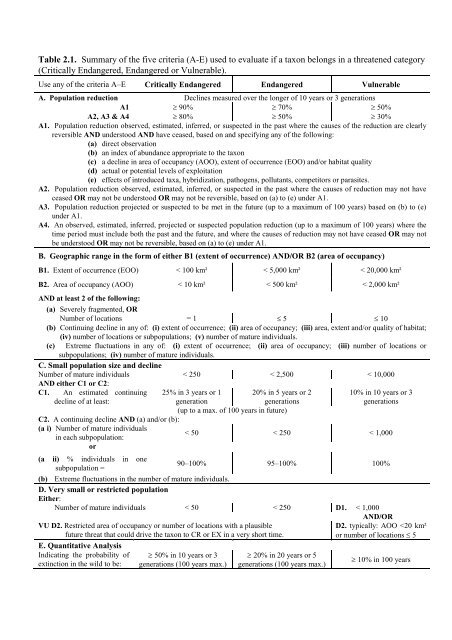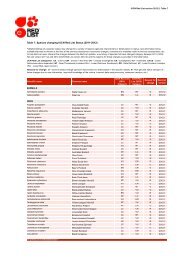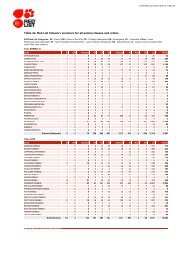IUCN Red List Guidelines - The IUCN Red List of Threatened Species
IUCN Red List Guidelines - The IUCN Red List of Threatened Species
IUCN Red List Guidelines - The IUCN Red List of Threatened Species
You also want an ePaper? Increase the reach of your titles
YUMPU automatically turns print PDFs into web optimized ePapers that Google loves.
Table 2.1. Summary <strong>of</strong> the five criteria (A-E) used to evaluate if a taxon belongs in a threatened category<br />
(Critically Endangered, Endangered or Vulnerable).<br />
Use any <strong>of</strong> the criteria A–E Critically Endangered Endangered Vulnerable<br />
A. Population reduction Declines measured over the longer <strong>of</strong> 10 years or 3 generations<br />
A1 ≥ 90% ≥ 70% ≥ 50%<br />
A2, A3 & A4 ≥ 80% ≥ 50% ≥ 30%<br />
A1. Population reduction observed, estimated, inferred, or suspected in the past where the causes <strong>of</strong> the reduction are clearly<br />
reversible AND understood AND have ceased, based on and specifying any <strong>of</strong> the following:<br />
(a) direct observation<br />
(b) an index <strong>of</strong> abundance appropriate to the taxon<br />
(c) a decline in area <strong>of</strong> occupancy (AOO), extent <strong>of</strong> occurrence (EOO) and/or habitat quality<br />
(d) actual or potential levels <strong>of</strong> exploitation<br />
(e) effects <strong>of</strong> introduced taxa, hybridization, pathogens, pollutants, competitors or parasites.<br />
A2. Population reduction observed, estimated, inferred, or suspected in the past where the causes <strong>of</strong> reduction may not have<br />
ceased OR may not be understood OR may not be reversible, based on (a) to (e) under A1.<br />
A3. Population reduction projected or suspected to be met in the future (up to a maximum <strong>of</strong> 100 years) based on (b) to (e)<br />
under A1.<br />
A4. An observed, estimated, inferred, projected or suspected population reduction (up to a maximum <strong>of</strong> 100 years) where the<br />
time period must include both the past and the future, and where the causes <strong>of</strong> reduction may not have ceased OR may not<br />
be understood OR may not be reversible, based on (a) to (e) under A1.<br />
B. Geographic range in the form <strong>of</strong> either B1 (extent <strong>of</strong> occurrence) AND/OR B2 (area <strong>of</strong> occupancy)<br />
B1. Extent <strong>of</strong> occurrence (EOO) < 100 km² < 5,000 km² < 20,000 km²<br />
B2. Area <strong>of</strong> occupancy (AOO) < 10 km² < 500 km² < 2,000 km²<br />
AND at least 2 <strong>of</strong> the following:<br />
(a) Severely fragmented, OR<br />
Number <strong>of</strong> locations = 1 ≤ 5 ≤ 10<br />
(b) Continuing decline in any <strong>of</strong>: (i) extent <strong>of</strong> occurrence; (ii) area <strong>of</strong> occupancy; (iii) area, extent and/or quality <strong>of</strong> habitat;<br />
(iv) number <strong>of</strong> locations or subpopulations; (v) number <strong>of</strong> mature individuals.<br />
(c) Extreme fluctuations in any <strong>of</strong>: (i) extent <strong>of</strong> occurrence; (ii) area <strong>of</strong> occupancy; (iii) number <strong>of</strong> locations or<br />
subpopulations; (iv) number <strong>of</strong> mature individuals.<br />
C. Small population size and decline<br />
Number <strong>of</strong> mature individuals < 250 < 2,500 < 10,000<br />
AND either C1 or C2:<br />
C1. An estimated continuing<br />
decline <strong>of</strong> at least:<br />
25% in 3 years or 1 20% in 5 years or 2<br />
generation<br />
generations<br />
(up to a max. <strong>of</strong> 100 years in future)<br />
C2. A continuing decline AND (a) and/or (b):<br />
(a i) Number <strong>of</strong> mature individuals<br />
in each subpopulation:<br />
or<br />
< 50 < 250 < 1,000<br />
10% in 10 years or 3<br />
generations<br />
(a ii) % individuals<br />
subpopulation =<br />
in one<br />
90–100% 95–100% 100%<br />
(b) Extreme fluctuations in the number <strong>of</strong> mature individuals.<br />
D. Very small or restricted population<br />
Either:<br />
Number <strong>of</strong> mature individuals < 50 < 250 D1. < 1,000<br />
VU D2. Restricted area <strong>of</strong> occupancy or number <strong>of</strong> locations with a plausible<br />
future threat that could drive the taxon to CR or EX in a very short time.<br />
E. Quantitative Analysis<br />
Indicating the probability <strong>of</strong><br />
extinction in the wild to be:<br />
≥ 50% in 10 years or 3<br />
generations (100 years max.)<br />
≥ 20% in 20 years or 5<br />
generations (100 years max.)<br />
AND/OR<br />
D2. typically: AOO






